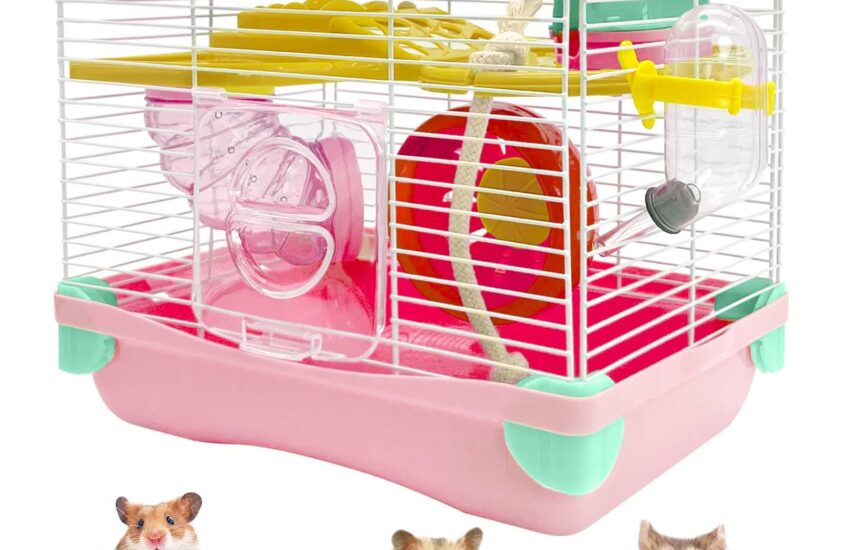Best Habitats for Different Hamster Types
Creating an appropriate habitat is crucial for ensuring the well-being of hamsters. Different hamster species have unique needs and preferences in their living environments. In this article, we will explore the best habitats for various hamster types, covering Syrian hamsters, dwarf hamsters, and more. By understanding their requirements, you’ll be equipped to provide a comfortable, safe, and enriching space for your furry friends.
Choosing the Right Habitat for Syrian Hamsters
Syrian hamsters, also known as golden hamsters, are the largest of the common hamster breeds, requiring ample space to thrive. The ideal habitat should be at least 24 inches long, 12 inches wide, and 12 inches high. A spacious multi-level cage allows them to climb and explore, enhancing their exercise and mental stimulation. It’s important to ensure proper ventilation and utilize a solid bottom cage, as wire flooring can hurt their delicate feet.
Cage Materials and Design
When selecting a habitat for Syrian hamsters, consider cages made from materials like glass or plastic, as these are easy to clean and offer good visibility. Adding accessories like tunnels, chews, and hideaways creates an engaging environment. Include a deep layer of bedding to allow for digging, which is a natural behavior. These elements not only enhance your hamster’s quality of life but also provide opportunities for exploration.

Feeding and Watering Stations
In addition to housing, proper feeding stations are essential. Syrian hamsters benefit from heavy ceramic bowls that prevent tipping. Fresh food should be provided daily, along with a constant supply of clean water. Bottles mounted on the cage’s side help keep the habitat hygienic and prevent bedding from getting wet. Regular cleaning of the feeding areas maintains a clean living space for your hamster.
Optimal Habitats for Dwarf Hamsters
Dwarf hamsters, which include species like Campbell’s and Roborovski hamsters, have different habitat needs due to their smaller size. A comfortable habitat for dwarf hamsters can be slightly smaller than that of Syrian hamsters, with dimensions of about 20 by 10 inches. Hamsters of this breed are often social and enjoy having companions, so consideration for space and mates is important.
Creating a Social Environment
Dwarf hamsters thrive when housed in pairs or small groups, provided they are of the same species and are introduced properly. A habitat that allows for multiple hiding spots can reduce stress and territorial behaviors. Add several tunnels, tubes, and shelters within the cage to support their natural burrowing instincts. This layout encourages play and exploration, which is vital for their happiness and health.

Bedding and Nesting Materials
Choosing the right bedding is crucial. Opt for safe, non-toxic materials such as aspen shavings or paper-based bedding. Avoid cedar or pine shavings, as these can be harmful to your hamster’s respiratory system. Dwarf hamsters love to nest; providing nesting materials like shredded paper or hay will make them feel at home. Regularly check and clean the substrate to keep their environment fresh.
Care Considerations for Chinese and Campbell’s Hamsters
Chinese and Campbell’s hamsters are unique and require special considerations in their habitats. Chinese hamsters are particularly agile climbers, so multi-story cages are beneficial. Campbell’s hamsters benefit from a mix of vertical and horizontal space, making it vital to design habitats that address these needs effectively.
Providing Enrichment and Exercise Opportunities
Adding wheels is essential for both types. Ensure it’s a solid bottom wheel to prevent injuries to their feet. Place climbing equipment like branches or platforms to encourage natural behaviors. Lee Masch’s “Hamster Wheel versus Tube” debate highlights how providing diverse equipment can lead to better well-being among hamsters. A varied habitat keeps these supreme explorers engaged and physically active.

Regular Monitoring and Adjusting Conditions
Regularly monitoring conditions in their habitats is vital for health. Assess humidity and temperature levels, as extreme changes can negatively affect your hamster. Ensure they have access to shaded areas to retreat when they need to cool off. A tip is to seasonally adjust bedding thickness according to your locale’s climate. Consistently providing the right environment ensures that your hamsters remain happy and healthy.
Final Thoughts on Hamster Habitats
Creating the perfect habitat for your hamster type requires understanding their specific needs and behaviors. From the spacious environments favored by Syrian hamsters to the cozy, multi-dimensional habitats preferred by dwarf hamsters, each species has distinct requirements. Prioritizing space, enrichment, and proper care helps ensure your pets are healthy and content. Investing time and effort into designing an optimal habitat will lead to happier hamsters, which in turn leads to joyful hamster owners.
FAQ
1. What size habitat is ideal for a Syrian hamster?
The ideal habitat for a Syrian hamster should be a minimum of 24x12x12 inches. Larger cages provide more space for exercising and exploring, which is important for their physical and mental well-being.
2. Can dwarf hamsters live together?
Yes, dwarf hamsters like Campbell’s and Roborovski can live together, but they must be introduced properly. They thrive in pairs or small groups if their habitat is appropriately designed with hiding spots.
3. Is it safe to use pine or cedar bedding for hamsters?
No, it’s not safe. Pine and cedar bedding can cause respiratory issues. Opt for non-toxic bedding such as aspen shavings or paper-based bedding to ensure your hamster’s health.
4. How often should I clean my hamster’s habitat?
You should clean your hamster’s habitat at least once a week. Spot cleaning should be done daily to remove waste and uneaten food, maintaining a hygienic environment for your pet.
5. What enrichment items are best for hamsters?
High-quality enrichment items include tunnels, chew toys, and climbing platforms. Providing a wheel is essential for exercise, while nests or hiding spots allow hamsters to feel secure.
6. How can I ensure my hamster stays healthy and happy?
Monitor your hamster’s habitat, provide a balanced diet, maintain cleanliness, and offer exercise opportunities. Regular handling and social interaction also contribute to their happiness and health.
